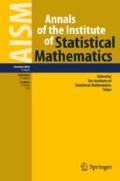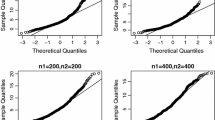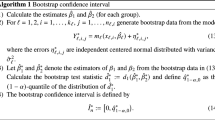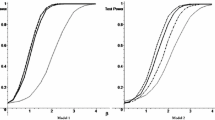Abstract
This article studies the problem whether two convex (concave) regression functions modelling the relation between a response and covariate in two samples differ by a shift in the horizontal and/or vertical axis. We consider a nonparametric situation assuming only smoothness of the regression functions. A graphical tool based on the derivatives of the regression functions and their inverses is proposed to answer this question and studied in several examples. We also formalize this question in a corresponding hypothesis and develop a statistical test. The asymptotic properties of the corresponding test statistic are investigated under the null hypothesis and local alternatives. In contrast to most of the literature on comparing shape invariant models, which requires independent data the procedure is applicable for dependent and non-stationary data. We also illustrate the finite sample properties of the new test by means of a small simulation study and two real data examples.




Similar content being viewed by others
References
Ait-Sahalia, Y., Duarte, J. (2003). Nonparametric option pricing under shape restrictions. Journal of Econometrics, 116, 9–47.
Carroll, R. J., Hall, P. (1993). Semiparametric comparison of regression curves via normal likelihoods. Australian Journal of Statistics, 34(3), 471–487.
Collier, O., Dalalyan, A. S. (2015). Curve registration by nonparametric goodness-of-fit testing. Journal of Statistical Planning and Inference, 162, 20–42.
Dahlhaus, R. (1997). Fitting time series models to nonstationary processes. The Annals of Statistics, 25(1), 1–37.
Degras, D., Xu, Z., Zhang, T., Wu, W. B. (2012). Testing for parallelism among trends in multiple time series. IEEE Transactions on Signal Processing, 60(3), 1087–1097.
de Jong, P. (1987). A central limit theorem for generalized quadratic forms. Probability Theory and Related Fields, 75(2), 261–277.
Dette, H., Munk, A. (1998). Nonparametric comparison of several regression curves: Exact and asymptotic theory. Annals of Statistics, 26(6), 2339–2368.
Dette, H., Neumeyer, N. (2001). Nonparametric analysis of covariance. Annals of Statistics, 29(5), 1361–1400.
Dette, H., Wu, W. (2019). Detecting relevant changes in the mean of non-stationary processes: A mass excess approach. The Annals of Statistics, 47(6), 3578–3608.
Dette, H., Neumeyer, N., Pilz, K. F. (2006). A simple nonparametric estimator of a strictly monotone regression function. Bernoulli, 12, 469–490.
Durot, C., Groeneboom, P., Lopuhaä, H. P. (2013). Testing equality of functions under monotonicity constraints. Journal of Nonparametric Statistics, 25(4), 939–970.
Gamboa, F., Loubes, J., Maza, E. (2007). Semi-parametric estimation of shifts. Electronic Journal of Statistics, 1, 616–640.
Hall, P., Hart, J. D. (1990). Bootstrap test for difference between means in nonparametric regression. Journal of the American Statistical Association, 85(412), 1039–1049.
Hall, P., Huang, L.-S. (2001). Nonparametric kernel regression subject to monotonicity constraints. Annals of Statistics, 29(3), 624–647.
Härdle, W., Marron, J. S. (1990). Semiparametric comparison of regression curves. Annals of Statistics, 18(1), 63–89.
Kneip, A., Engel, J. (1995). Model estimation in nonlinear regression under shape invariance. The Annals of Statistics, 46, 551–570.
Maity, A. (2012). A powerful test for comparing multiple regression functions. Journal of Nonparametric Statistics, 24(3), 563–576.
Mallat, S., Papanicolaou, G., Zhang, Z. (1998). Adaptive covariance estimation of locally stationary processes. The Annals of Statistics, 26(1), 1–47.
Mammen, E. (1991). Estimating a smooth monotone regression function. Annals of Statistics, 19(2), 724–740.
Matzkin, R. L. (1991). Semiparametric estimation of monotone and concave utility functions for polychotomous choice models. Econometrica, 59(5), 1315–1327.
Nason, G. P., Von Sachs, R., Kroisandt, G. (2000). Wavelet processes and adaptive estimation of the evolutionary wavelet spectrum. Journal of the Royal Statistical Society: Series B (Statistical Methodology), 62(2), 271–292.
Neumeyer, N., Dette, H. (2003). Nonparametric comparison of regression curves: An empirical process approach. Annals of Statistics, 31(3), 880–920.
Neumeyer, N., Pardo-Fernández, J. C. (2009). A simple test for comparing regression curves versus one-sided alternatives. Journal of Statistical Planning and Inference, 139(12), 4006–4016.
Ombao, H., Von Sachs, R., Guo, W. (2005). Slex analysis of multivariate nonstationary time series. Journal of the American Statistical Association, 100(470), 519–531.
Park, C., Hannig, J., Kang, K.-H. (2014). Nonparametric comparison of multiple regression curves in scale-space. Journal of Computational and Graphical Statistics, 23(3), 657–677.
Rønn, B. (2001). Nonparametric maximum likelihood estimation for shifted curves. Journal of the Royal Statistical Society, Series B, 63(2), 243–259.
Varian, H. R. (1984). The nonparametric approach to production analysis. Econometrica, 52(3), 579–597.
Vilar-Fernández, J. M., Vilar-Fernández, J. A., González-Manteiga, W. (2007). Bootstrap tests for nonparametric comparison of regression curves with dependent errors. TEST, 16(1), 123–144.
Vimond, M. (2010). Efficient estimation for a subclass of shape invariant models. Annals of Statistics, 38(3), 1885–1912.
Vogt, M. (2012). Nonparametric regression for locally stationary time series. The Annals of Statistics, 40(5), 2601–2633.
Wu, W. B., Zhou, Z. (2011). Gaussian approximations for non-stationary multiple time series. Statistica Sinica, 21(3), 1397–1413.
Zhou, Z. (2010). Nonparametric inference of quantile curves for nonstationary time series. The Annals of Statistics, 38(4), 2187–2217.
Zhou, Z., Wu, W. B. (2009). Local linear quantile estimation for nonstationary time series. The Annals of Statistics, 37(5B), 2696–2729.
Zhou, Z., Wu, W. B. (2010). Simultaneous inference of linear models with time varying coefficients. Journal of the Royal Statistical Society: Series B (Statistical Methodology), 72(4), 513–531.
Acknowledgements
The first author has been supported by the Collaborative Research Center “Statistical modelling of nonlinear dynamic processes” (SFB 823, Teilprojekt A1, C1) of the German Research Foundation (DFG). The second author is supported by MATRICS (MTR/2019/000039), a research grant from the SERB, Government of India and in part by SFB 823. The third author is supported by NSFC Young program (No.11901337) (a research grant of China) and in part by SFB 823. The authors are grateful to the referees and the Associate Editor for their constructive comments on an earlier version of this paper and to Martina Stein, who typed parts of this paper with considerable technical expertise.
Author information
Authors and Affiliations
Corresponding author
Additional information
Publisher's Note
Springer Nature remains neutral with regard to jurisdictional claims in published maps and institutional affiliations.
Appendix: Proofs
Appendix: Proofs
1.1 Preliminaries
In this section, we state a few auxiliary results, which will be used later in the proof. We begin with Gaussian approximation. A proof of this result can be found in Wu and Zhou (2011).
Proposition 10
Let
and assume that the Assumption 1is satisfied. Then on a possibly richer probability space, there exists a process \(\{{\mathbf {S}}_i^\dag \}_{i\in {\mathbb {Z}}}\) such that
(equality in distribution), and a sequence of independent 2-dimensional standard normal distributed random variables \(\{{\mathbf {V}}_i\}_{i\in {\mathbb {Z}}}\), such that
where \(\varSigma (t)\) is the square root of the long-run variance matrix \(\varSigma ^2(t)\) defined in Assumption 1.
Proposition 11
Let Assumption 1and 2be satisfied.
-
(i)
For \(s=1,2\) we have
$$\begin{aligned}&\sup _{ t\in [b_{n,s},1-b_{n,s}]}\Big | {\hat{m}}_s^{\prime}(t)-m_s^{\prime}(t)-\frac{1}{n_sb_{n,s}^2} \sum _{i=1}^{n_s}K^\circ \Big (\frac{i/n_s-t}{b_{n,s}}\Big )e_{i,s}\Big | \nonumber \\&\quad =O_P\Big (\frac{1}{n_sb_{n,s}^2}+b_{n,s}^2\Big ) \end{aligned}$$(33)where the kernel \(K^\circ \) is defined in (23).
-
(ii)
For \(s=1,2\)
$$\begin{aligned}&\sup _{t\in [b_{n,s},1-b_{n,s}]}\Big |\frac{1}{n_sb_{n_s}^2}\sum _{i=1}^{n_s} K^\circ \Big (\frac{i/n_s-t}{b_{n,s}}\Big )\Big (e_{i,s}-\sigma _s(i/n) V_{i,s}\Big )\Big | \nonumber \\&\quad = o_p\Big (\frac{\log ^2n_s}{n^{3/4}_sb_{n,s}^2}\Big ), \end{aligned}$$(34)where \(\{ V_{i,s}, \, i=1, \ldots , n_s ,s=1,2\}\) denotes a sequence of independent standard normal distributed random variables.
-
(iii)
For \(s=1,2\) we have
$$\begin{aligned} \sup _{t\in [b_{n,s},1-b_{n,s}]}|{\hat{m}}^{\prime}_s(t)-m_s^{\prime}(t)|=O_p\Big (\frac{\log n_s}{\sqrt{n_sb_{n,s}}b_{n,s}}+\frac{\log ^2n_s}{n^{3/4}_sb_{n,s}^2}+b_{n,s}^2\Big ). \end{aligned}$$(35) -
(iv)
For \(s=1,2\) we have
$$\begin{aligned} \sup _{t\in [0,b_{n,s}]\cup [1-b_{n,s},1] }|{\hat{m}}^{\prime}_s(t)-m_s^{\prime}(t)|=O_p\Big (\frac{\log n_s}{\sqrt{nb_{n,s}}b_{n,s}}+\frac{\log ^2n_s}{n_s^{3/4}b_{n,s}^2}+b_{n,s}\Big ). \end{aligned}$$(36)
Proof
(i): Define for \(s=1,2\) and \(l=0,1,2\)
Straightforward calculations show that \( ({\hat{m}}_s(t), b_{n,s}{\hat{m}}_s'(t))^\top =S_{n,s}^{-1}(t)R_{n,s}(t) \) \((s=1,2)\), where
Note that Assumption 2 gives
uniformly with respect to \(t\in [b_{n,s},1-b_{n,s}]\). The first part of the proposition now follows by a Taylor expansion of \(R_{n,s,l}(t)\).
(ii): The fact asserted in (34) follows from (33), Proposition 10, the summation by parts formula and similar arguments to derive equation (44) in Zhou (2010).
(iii) + (iv): Following Lemma C.3 of supplement of Dette and Wu (2019), we have
Finally, (35) follows from (33) (34) and (37) and (36) is obtained by similar arguments using Lemma C.3 in the supplement of Dette and Wu (2019). This completes the proof of Proposition 11. \(\square \)
1.2 Proof of Theorem 4
We only prove the result in the case \(g \equiv 0 \). The general case follows by the same arguments. Under Assumptions 1 and 2, it follows from the proof of Theorem 4.1 in Dette and Wu (2019) that
in probability, where \({\hat{f}}_{1} (t)\) and \({\hat{f}}_{2}(t)\) are defined in (10) and (11), respectively. Next, since under the null hypothesis (5), \(((m_1^{\prime})^{-1}(t))^{\prime} - ((m_{2}^{\prime})^{-1})^{\prime}(t) = 0\) for all \(t\in (a+\eta , b - \eta )\), (See Lemma 1) we have under the null hypothesis,
in probability. In other words, under \(H_{0}\), for any \(\epsilon > 0\), we have
and hence, under the null hypothesis \(g \equiv 0\), we have \({\mathbb {P}} [{{\mathcal {C}}}_{n_1,n_2}\subset L(\epsilon )] = 1\). \(\square \)
1.3 Proof of Theorem 5
To simplify the notation, we prove Theorem 5 in the case of equal sample sizes and equal bandwidths. The general case follows by the same arguments with an additional amount of notation. In this case \(c_2=r_2=1\) and we omit the subscript in bandwidths if no confusion arises, for example, we write \(n_1=n_2=n\), \(b_{n,1}=b_{n,2} =b_n\) and use a similar notation for other symbols depending on the sample size. In particular, we write \(T_n\) for \(T_{n_1,n_2}\) if \( n= n_1=n_2\).
Define the statistic
which is obtained from \(T_n\) by replacing the weight function \({\hat{w}}\) in (18) by its deterministic analogue (20). We shall show Theorem 5 in two steps proving the assertions
For (39), the difference \({\tilde{T}}_n-T_n\) is contributed by \({\hat{w}}(t)-w(t)\). The arguments of proving (38) are useful for the proof of (39) and are mathematically involved. We shall discuss the proof of (38) in detail in the next subsection.
1.3.1 Proof of (38)
By simple algebra, we obtain the decomposition
where for \(s=1,2\)
We shall study \(I_s(t)\), \(s=1,2\) and II(t) via borrowing the idea of proof of Theorem 4.1 of Dette and Wu (2019). In fact, the functions \(m^{\prime}_s\) and \({\hat{m}}^{\prime}_s\) for \(s=1,2\) here play a similar role as the functions \(\mu \) and \({\tilde{\mu }}_{b_n}\) in Dette and Wu (2019). Observing the estimate on page 471 of Dette et al. (2006) it follows
(\(s=1,2\)) which yields the estimate
uniformly with respect to \(t\in [a+\eta ,b-\eta ]\). For the two other terms, we use a Taylor expansion and obtain the decomposition
where
for some \(\theta _s\in [-1,1]\) (\(s=1,2\)). In the following, we shall prove (38) in the following steps.
-
(a)
Using arguments of Dette and Wu (2019) we show that the leading term of \(I_s(t)\) is \(I_{s,1}(t)\), \(s=1,2\).
-
(b)
Using Proposition 11, we approximate the leading term of \(I_{1,1}(t)-I_{2,1}(t)\) via a Gaussian process. Therefore, \(T_n\) has the form
$$\begin{aligned} T_n=\int \left( U_n(t)+((m^{\prime}_1)^{-1}(t))^{\prime}-((m^{\prime}_2)^{-1}(t))^{\prime}+R_n^\dag (t)\right) ^2w(t)dt, \end{aligned}$$where \(U_n(t)\) is a Gaussian process and \(R_n^\dag (t)\) is a negligible remaining term.
-
(c)
Under the considered alternative hypothesis, the asymptotic distribution is determined by \(\int U_n(t)^2w(t)dt\) and \(\int (((m^{\prime}_1)^{-1}(t))^{\prime}-((m^{\prime}_2)^{-1}(t))^{\prime})^2w(t)dt\). The latter accounts for a part of the bias. The former produces another part of the bias and determines the asymptotic stochastic behaviour. All terms in the expansion of \(T_n\) that involves \(R_n^\dag (t)\) are negligible.
-
(\(c_1\)) Further calculations show \(U_n(t)=U_{n,1}(t)-U_{n,2}(t)\), where
$$\begin{aligned} U_{n,s}(t)=\displaystyle \sum _{j=1}^nG(m_s^{\prime}(\cdot ),j,t)V_{j,s}\,\, \,\, \,\, \,\, \,\, (s=1,2), \end{aligned}$$where \(G(m_s^{\prime}(\cdot ),j,t)\) depends on the kernels, curves, long-run variances and bandwidths. Using a Riemann sum approximation, we can further simplify the leading term of \(G(m_s^{\prime}(\cdot ),j,t)\), and hence, the leading term of \(\int (U_n(t))^2(t)w(t)dt\) is a quadratic Gaussian.
-
(\(c_2\)) The asymptotic normality is then guaranteed by Theorem 2.1 of de Jong (1987). The mean and variance are obtained via straightforward but tedious calculations and certain arguments from Zhou (2010).
-
-
(d)
Finally, we show that \(\int U_n(t)(((m^{\prime}_1)^{-1}(t))^{\prime}-((m^{\prime}_2)^{-1}(t))^{\prime})w(t)dt\) and \(\int U_n(t)R_n^\dag (t)w(t)dt\) are negligible.
Step (a): By part (iii) and (iv) of Proposition 11 and the same arguments that were used in the online supplement of Dette and Wu (2019), to obtain the bound for the term \(\varDelta _{2,N}\) in the proof of their Theorem 4.1 it follows that
uniformly with respect to \(t\in [a+\eta ,b-\eta ]\). Here, we used the fact that the number of nonzero summands in \(I_{s,2}(t)\) is of order \(O(h_d+\pi _n)\).
Step (b): Next, for the investigation of the difference \(I_{1,1}(t)-I_{2,1}(t)\), we define \({\mathbf {m}}^{\prime}= (m_1,m_2) \) and consider the vector
By part (i) and (ii) of Proposition 11, it follows that there exists independent 2-dimensional standard normally distributed random vectors \({\mathbf {V}}_i \) such that
uniformly with respect to \(t\in [a+\eta ,b-\eta ]\). Combining this estimate with equations (42) and (43), it follows
where
and the remainder \(R_n^\dag (t)\) can be estimated as follows
Step (c): We now study the asymptotic properties of to the quantities
which determine the asymptotic distribution of \(T_{n}\) since the bandwidth conditions yield under local alternatives in the case \((m_1^{-1}(t))^{\prime}-(m_2^{-1}(t))^{\prime}=\rho _ng(t)\),
and the other parts of the expansion are negligible, i.e.
Step (\(c_1\)): Asymptotic properties of (47): To address the expressions related to \(U_n(t)\) in (47)–(49) note that
where
for \(s=1,2\), and \(\{V_{j,s}\}\) are independent standard normal distributed random variables. In order to simplify the notation, we define the quantities
where
A straightforward calculation (using the change of variable \(v=(m_s^{\prime}(u)-t)/h_d\)) shows that
where \({\mathcal {A}}_s(t) {\mathcal {A}}_s(t) =\big (\frac{m_s^{\prime}(0)-t}{h_d},\frac{ m_s^{\prime}(1)-t}{h_d}\big ), \) the remainder is given by
and \({\mathbf {1}} (A) \) denote the indicator function of the set A. As the kernel \(K^{\prime}_d(\cdot )\) has a compact support and is symmetric, it follows by a Taylor expansion for any t with \(w(t)\ne 0\)
With the notation
(\(s=1,2\)) we thus obtain the approximation
where the remainder satisfy
Let us now consider the statistics \({\tilde{U}}_{n,s}(t)=\sum _{j=1}^n{\tilde{G}}(m_s^{\prime}(\cdot ),j,t)V_{j,s}\) (\(s=1,2\)), and
then, by the previous calculations, it follows that
and therefore, we investigate the weak convergence of \(nb_n^{9/2} \int {\tilde{U}}_n^2(t)w(t)dt\) in the following. For this purpose, we use a similar decomposition as in (53) and obtain
where the last equation defines \(D_1,D_2\) and \(D_3\) in an obvious manner.
Step \((c_2)\): Elementary calculations (using a Taylor expansion and the fact that the kernels have compact support) show that
where \(\kappa _K= \int vK^{\prime}_d(v)dv\). Using the estimate
(uniformly with respect to \(t\in [a+\eta , b-\eta ]\)) and (57) gives
which implies
where \(B_n (g)\) is defined in Theorem 5 (and we use the notation with the function \(g \equiv 0\)). Here, we used the change of variable \((m_s^{\prime})^{-1}(t)=u\), and afterwards, \(((m_s')^{-1})'(t)=\frac{1}{m_s''((m_s')^{-1}(t))}\). Similar arguments establish that
where the first estimate is obtained from the fact that \(\int G^2(m_s^{\prime}(\cdot ),j,t)w(t)dt=O(b_n/(nb_n^3))\). This leads to the estimate
For the term \(D_3\) in the decomposition (56), it follows that
Hence,
Finally, we investigate the term \(D_2\) using a central limit theorem for quadratic forms (see de Jong 1987). For this purpose define the term (note that \((K^\circ )^{\prime}(\cdot )\) is symmetric and has bounded support)
then \(\lim _{n\rightarrow \infty } V_{s,n} / (n^2 b_n^3) \) exists \((s=1,2\)) and
where the asymptotic variance \(V_T\) is defined in Theorem 5. Now similar arguments as in the proof of Lemma 4 in Zhou (2010) show that \( nb^{9/2}_nD_2\Rightarrow {N(0,V_{T}),} \) Combining this statement with (55), (56), (58), (59), and (60) finally gives
Step (d):
Asymptotic properties of (48): Define \(d(t)= ((m_1^{-1})^{\prime}-(m_2^{-1})^{\prime}) \) and note that
where
Observing that \( \int G(m_s^{\prime}(\cdot ),j,t)\rho _ng(t)w(t)dt=O(\rho _nb_n/(nb_n^3)), \) the bandwidth conditions and the definition of \(\rho _n\) give for \(s=1,2\),
Asymptotic properties of (49): Note that it follows for the term (49)
Observing that \(\displaystyle \sum _jG^2(m_s^{\prime}(\cdot ),j,t)=O(nb_n/(nb_n^3)^2)\) we have
and the conditions on the bandwidths and (46) yield
The proof of assertion (38) is now completed using the decomposition (44) and the results (50), (51), (52), (61), (62) and (63). \(\square \)
1.3.2 Proof of (39)
From the proof of (38), we have the decomposition
where quantities \(I_s\), II, \(U_n(t)\) and \(R_n^\dag (t)\) are defined in (40), (41), and (45). By the proof of (38), it then suffices to show that
Using the same arguments as given in the proof of (38), this assertion follows from \( nb_n^{9/2}\int ({\tilde{U}}_n(t))^2({\hat{w}}(t)-w(t))dt=o_p(1), \) where \({\tilde{U}}_n(t)\) is defined in (54). Recalling the definition of a, b in (20) it then follows (using similar arguments as given for the derivation of (37)) that \( \sup _{t\in [a,b]}|{\tilde{U}}_n(t)|=O_p\left( \frac{\log n}{\sqrt{nb_{n}}b^2_n}\right) . \) Furthermore, together with part (iii) of Proposition 11 it follows that
where \({\bar{\omega }}_n\) is defined in (22). Thus by our choices of bandwidth \(nb_n^{9/2}\frac{{\bar{\omega }}_n\log ^2 n}{nb_n^5}=o(1)\), from which result (ii) follows. Finally, the assertion of Theorem 5 follows from (38) and (39). \(\square \)
About this article
Cite this article
Dette, H., Dhar, S.S. & Wu, W. Identifying shifts between two regression curves. Ann Inst Stat Math 73, 855–889 (2021). https://doi.org/10.1007/s10463-020-00771-2
Received:
Revised:
Published:
Issue Date:
DOI: https://doi.org/10.1007/s10463-020-00771-2




